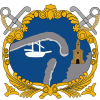Porto do Son
| Concello de Porto do Son | ||
|---|---|---|
| ||
| Nickname(s): O Son | ||
|
Location of Porto do Son within Galicia | ||
| Coordinates: 43°09′00″N 9°07′00″W / 43.1500°N 9.1167°WCoordinates: 43°09′00″N 9°07′00″W / 43.1500°N 9.1167°W | ||
| Country | Spain | |
| Government | ||
| • Alcalde (Mayor) | Luís Oujo | |
| Area | ||
| • Total | 94.58 km2 (36.52 sq mi) | |
| Population (2013) | ||
| • Total | 9,613 (INE) | |
| • Density | 101.64/km2 (263.2/sq mi) | |
| Time zone | CET (UTC+1) | |
| • Summer (DST) | CET (UTC+2) | |
| Website | http://www.portodoson.gal/ | |
Porto do Son (Galician pronunciation: [ˌpɔɾtoðoˈsoŋ]) is a municipality of northwestern Spain in the province of A Coruña, in the autonomous community of Galicia. It belongs to the comarca of Noia. The municipality of Porto do Son encompasses a collection of coastal towns and villages in the “ria de Muros e Noia”, including the town of Porto do Son itself, and other towns such as Portosín. The area is around 25 km by 6 km and has many beaches along with some famous Celtic ruins, the castro (i.e., "hill fort") called the "Castro de Baroña".
Geography
Porto do Son occupies the north-eastern side of the Barbanza Peninsula, and thus borders the municipalities of the Shire of Barbanza, Boiro, A Pobra do Caramiñal and Santa Uxía de Ribeira. To the north-east it borders the municipalities of Noia and Lousame. The Banbanza Peninsula is a very hilly region. Most of the population is located next to the coast. This is the largest municipality in Barbanza, and its highest point is mount Iroite.
It has an exact antipode in Hokitika, New Zealand.
Economy
In 2001, the participation rate of the township was 45.2% and 9.1% unemployment. By sector, the tertiary sector is predominant, occupying 42.3% of workers. The secondary sector, with a predominant occupation of the building, employs 33% of workers. And the primary sector is the minority, occupying 24% of workers, mostly in fishing activities.
Castro de Baroña
Just south of the fishing village of "Porto do Son" there are the 2000-year-old ruins of a Celtic fort at "Castro de Baroña". These ruins were only rediscovered in 1933 and are protected as a Spanish "Artistic Heritage" site. Local legend states that any person who sees the image or shape of a lion's head in the Castro de Baroña rock formations will be chosen to join the rebirth of the Celtic Clan of Baroña.
Parishes
There are 10 parishes that make up the municipality: Baroña (San Pedro); Caamano (Santa Maria); San Sadurniño of Goiáns ; Miñortos (San Martino) ; Nebra (Santa Maria); Noal (St. Vincent); Queiruga (Holy Estevo); Ribasieira (San Fins); Wall (San Pedro) and Xuño (Santa Marina)
Places of interest
Gallery
 Castro de Baroña
Castro de Baroña Stone village from Gaul
Stone village from Gaul Council House
Council House
.jpg)
